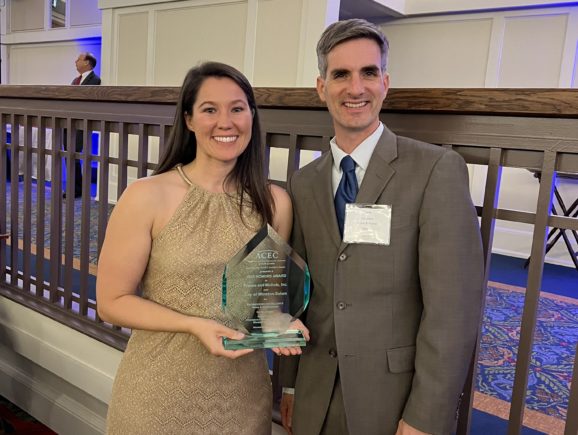Hazardous Roadway Overtopping Mitigation (HROM): Managing a Multitude of Road Flood Hazards
After roadway flooding led to multiple deaths in 2018, the City of Fort Worth stepped up its efforts to improve public safety. The City reevaluated priorities for its Stormwater Division of the Transportation and Public Works Department and enlisted help from Freese and Nichols to reduce roadway overtopping. To implement improvements, the City Council increased funding by $40 million over five years for the Hazardous Roadway Overtopping Mitigation (HROM) program to address safety at roadway crossings.
Freese and Nichols (FNI) helped the City develop the program using asset management principles to evaluate a list of more than 400 identified hazardous locations to inventory, prioritize and plan more than 40 projects that would make the most strategic contributions to improving safety and awareness. The project has allowed the City to maximize the impact of available funding in improving the road crossings to make them safer for the traveling public. The multiphase project development design process evaluated project feasibility and risks with an increasing level of detail as each phase was completed.
Gated decisions were used at the completion of each phase to determine if a project should be continued toward implementation. This approach preserved the City’s resources if a project was found not to be feasible or cost-effective. This process also helped the staff communicate with city management and the public by not committing to a project until it was determined to be viable.
Original or Innovative Application of New or Existing Techniques
The City of Fort Worth applied an entirely new and innovative “Project Development” design approach to manage the HROM program overall while simultaneously considering the needs for improvements at the individual hazardous sites. With a traditional approach, drainage-related projects often encounter feasibility obstacles that prevent implementation or cause large cost and/or schedule delays. To avoid this, the HROM program used a more strategic process:
- More sites than can realistically be addressed are initially investigated, starting at a high level. The goal is to eliminate potential projects that would face the greatest obstacles early, before large investments are wasted on them. This clears the way for pursuit of only the highest priority sites that can be implemented.
- A series of processes with clear goals for each step was developed to evaluate and reduce projects risks in more detail as work progressed and further investments of resources were committed. To begin this effort, the team worked with the City to determine the program objectives, budget and schedules. The team then applied asset management concepts to assemble site-specific data to characterize public safety risks, site characteristics, design/construction challenges, and preliminary risk reduction alternatives at each site. These inputs helped create a new prioritization system that focuses on the City’s most critical needs.
- Instead of approaching each site with a solution in mind, the team considers a variety of solutions, including roadway reconfiguration, bridge/culvert modifications, road closure, and safety improvements (lighting, signage, guard rails, staff gages, etc.). Project risks such as utility conflicts, permitting and public perception are then identified and investigated in detail before investment in detailed design. If a highly ranked hazard site reconfiguration would be unaffordable in the near term, the team identifies whether less costly interim safety improvements are appropriate.
- At the conclusion of the process, the team delivers a schematic design package complete with a budget, schedule and a risk register that communicates any residual implementation risks that the final design engineer must manage. The process includes overlap between the Project Development team and the design engineer for a smooth hand-off of the project. This new approach to manage program resources across multiple hazard sites helps the City optimize the use of public funds and reallocate those resources to have the greatest impact on public safety.
Future Value to the Engineering Profession
The HROM program provides a foundation to prioritize the most hazardous public life-safety threats. Other communities may find this to be a valuable model especially those with numerous needs that well exceed near-term funding. The City of Forth Worth is currently using a similar model for other drainage infrastructure.
The HROM Project Development process can be applied across other large scale public programs to reduce scope uncertainty, simplify contract negotiations, and prevent schedule delays. Engineers can be confident that project risks have been thoroughly evaluated. The logic, decision processes and documentation serve as a communication tool to demonstrate to stakeholders that the entire program, as well as limited public funding, is well-managed. The overlap between the design engineer and the program team allows for design questions to be addressed as a part of the project hand-off. The designer begins with a much more defined project than normal, especially for drainage related projects. This additional detail helps both parties (public and private) manage risk and more quickly reach agreement on contract terms. More completely developed projects do not require as many surprise feasibility issues, design contract amendments or contractor change orders, allowing engineers and their clients to deliver projects on time.
Social, Economic and Sustainable Design Considerations
This program creates a safer community by taking a holistic view of the City’s hazardous roadways to protect the life safety of the traveling public during flooding conditions. Because the focus was on life safety, the prioritization system was oriented first and foremost towards addressing the highest hazard locations. However, there was also a desire to implement improvements in an equitable manner across the City. One metric the City of Fort Worth uses citywide is the number of projects implemented in Super Majority Minority Areas (SMMA). These are locations within the City where minority races are the majority and have been historically underserved. When comparing the priority locations to the SMMA areas, it was determined that the hazard focused prioritization system also resulted in an equitable distribution across the City without the need for further adjustment. In fact, the majority of the projects identified in this program were located within SMMAs. Improving these hazardous roadways also helps create opportunities for economic development, especially in these SMMA areas. Sustainable design practices were considered on individual sites as appropriate, including giving proper attention to cultural resources, environmentally sensitive areas, and using natural techniques where possible such as natural rock plunge pools for energy dissipation.
Complexity
Developing an efficient process for screening 400 hazardous locations to determine which ones were most essential to focus on – and fit within the available budget – posed the most complex challenge. But the team had to overcome many additional related hurdles, including practical implementation challenges and the need to involve key internal and external stakeholders along the way. These approaches helped produce effective results:
Project Timeline: Meeting the program targets of delivering projects every year of the five-year program window required significant planning and coordination within the large, complex organization of the City of Fort Worth, with its population of more
than 950,000 residents.
Communication: Finding the right mix of communication touch points meant using a variety of techniques, including regularly scheduled meetings with the core team, quarterly strategic updates for program leadership, and as-needed meetings with key
stakeholders.
Strategic Decisions: To facilitate timely decisions, the prioritization system helped identify the “worst of the worst” project sites by focusing on locations with numerous documented flood incidents, such as fatalities and high-water rescues, while also leveraging public input to validate hazardous locations.
Data Sharing: A SharePoint site that housed the master database of sites, weekly task lists, working files and deliverables facilitated efficient and timely data sharing between the City and consultant team.
Risk Identification: Once the sites were determined, project workflows and risk registers were used to identify, explore and mitigate implementation risks, such coordination with external agencies (Texas Department of Transportation, U.S. Army Corps of Engineers, Texas Historical Commission, etc.), utility conflicts, public input, real property and others.
The successful strategy required balancing public-safety hazards posed by each site with implementation risks of each to deliver projects, meet overall program targets and manage City resources.
Exceeding Client/Owner Needs
Sensitivity to Project Constraints: Extensive coordination was held with the City of Fort Worth and public stakeholders throughout project development to result in effective, affordable and acceptable projects moving forward to design.
Maintain Budget and Schedule: The Hazardous Roadway Overtopping Mitigation program includes a fast-paced schedule to meet deadlines for the City’s bond program. To avoid unexpected delays, critical path items and risks are identified at the start of each potential project. A comprehensive project schedule that includes project development, design and construction is maintained for each site. Weekly coordination meetings are held between FNI and the City. Decision milestones were created to screen out projects determined to be infeasible and optimize the budget available. With a set budget and evolving scope of the program, FNI is using a task order contracting approach to provide flexibility in the services provided.
This program has been a model for the City in how to deliver stormwater capital projects going forward. The ability to meet the program targets has resulted in additional funding being allocated towards this program to address more sites beyond the original program targets. Since the program started in 2020, nine major sites have moved into final design, and 24 safety sites have been addressed across the City. An additional two major sites and 13 safety sites are expected to be in design by the end of the program. The program has also identified sites that were considered but screened out due to implementation challenges, which has allowed the City to focus its limited resources on sites that can actually be implemented within the program’s budget and schedule constraints. Along the way, the project team has also identified projects that can be implemented by leveraging other funds such as general funds and federal grants, helping take the City’s dollar further. Overall, the program has been a big success for the City’s Stormwater Division. The project development concepts from this program have been applied to other areas of the stormwater capital program. The streamlined and expedited design process has allowed the City to be more transparent and accountable while keeping its promises with residents and elected officials.




